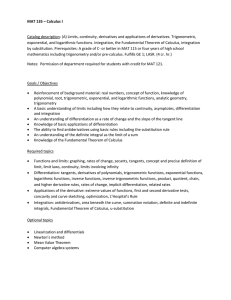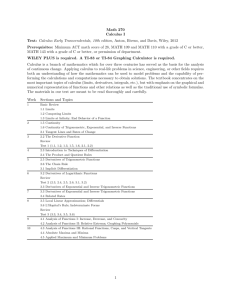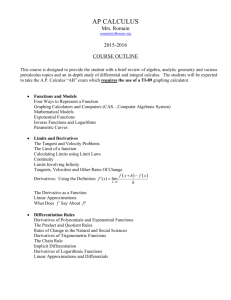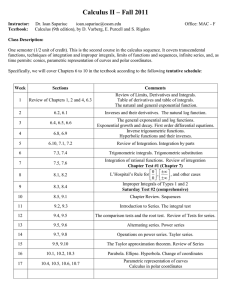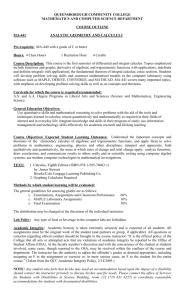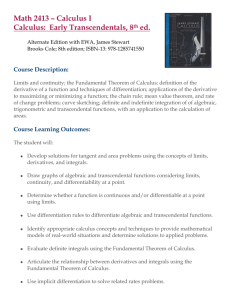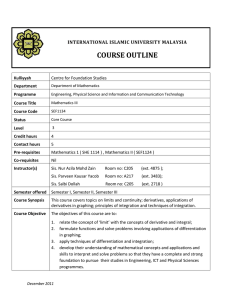Calc AB Course Syllabus
advertisement
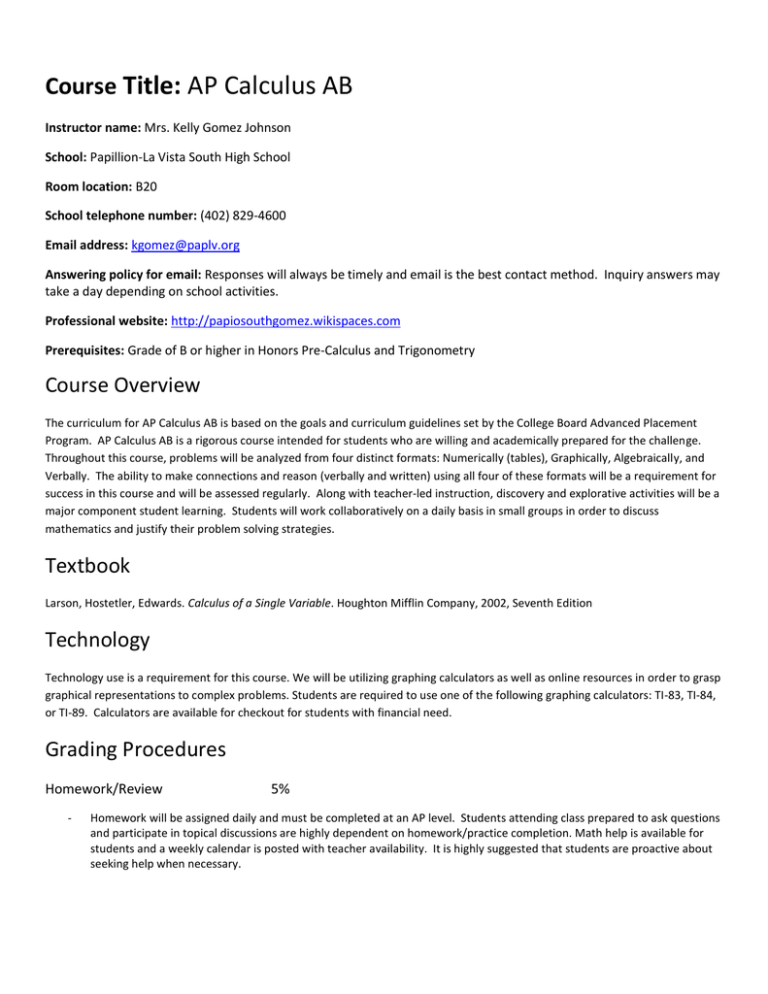
Course Title: AP Calculus AB Instructor name: Mrs. Kelly Gomez Johnson School: Papillion-La Vista South High School Room location: B20 School telephone number: (402) 829-4600 Email address: kgomez@paplv.org Answering policy for email: Responses will always be timely and email is the best contact method. Inquiry answers may take a day depending on school activities. Professional website: http://papiosouthgomez.wikispaces.com Prerequisites: Grade of B or higher in Honors Pre-Calculus and Trigonometry Course Overview The curriculum for AP Calculus AB is based on the goals and curriculum guidelines set by the College Board Advanced Placement Program. AP Calculus AB is a rigorous course intended for students who are willing and academically prepared for the challenge. Throughout this course, problems will be analyzed from four distinct formats: Numerically (tables), Graphically, Algebraically, and Verbally. The ability to make connections and reason (verbally and written) using all four of these formats will be a requirement for success in this course and will be assessed regularly. Along with teacher-led instruction, discovery and explorative activities will be a major component student learning. Students will work collaboratively on a daily basis in small groups in order to discuss mathematics and justify their problem solving strategies. Textbook Larson, Hostetler, Edwards. Calculus of a Single Variable. Houghton Mifflin Company, 2002, Seventh Edition Technology Technology use is a requirement for this course. We will be utilizing graphing calculators as well as online resources in order to grasp graphical representations to complex problems. Students are required to use one of the following graphing calculators: TI-83, TI-84, or TI-89. Calculators are available for checkout for students with financial need. Grading Procedures Homework/Review - 5% Homework will be assigned daily and must be completed at an AP level. Students attending class prepared to ask questions and participate in topical discussions are highly dependent on homework/practice completion. Math help is available for students and a weekly calendar is posted with teacher availability. It is highly suggested that students are proactive about seeking help when necessary. Final Exam - Final exams will be in preparation for students taking the AP Exam in May. Final exam formats will be a combination of multiple choice and free response questions, and will also be both calculator and non-calculator. The second semester final will be a practice AP Exam representing all Calculus material covered throughout the year in order to better prepare students for the AP Exam in early May. AP Test Prep - 25% Quizzes will be announced and administered 1-2 times per chapter in order to formatively assess student learning and understanding. It is expected that students are highly prepared for quizzes. It is expected that students seek help and complete corrections on quizzes before their summative assessment (test). Tests - 10% Students will be given problems throughout the year in order to help prepare for the AP exam. All problems will be sample problems or problems from retired AP exams. These activities and assignments will be rigorous and will be graded on rubrics provided by college board. Quizzes/Projects - 10% 50% Tests will be given at the end of each chapter. Topics covered on tests will be representative of the accumulation of the chapters previously covered. Tests will be comprised of both multiple choice and short answer questions and will be both with and without the use of a calculator. There are no tests re-takes in AP Calculus. Daily Required Materials - ALL PRACTICE/ HOMEWORK is to be done on GRAPH PAPER (graph paper notebooks work great!) COVERED Textbook, Pencils, and Graphing Calculator NO cell phones OR iPods may be used on any quiz or test…no exceptions! ORGANIZED system for notes and homework. Reminder: We are preparing you for the AP Exam whether that be the real test or your final exam. These will cover topics from the entire year. Expectations for class participation and behavior You have chosen to take an AP mathematics course, and you will be asked to act and perform at this level. The following traits and procedures are expectations for this course: Be in class, on time, and prepared. Be respectful of oneself, others, and property. Follow classroom procedures and activities (ie: participate in group discussions and explorations, note taking, and classroom practice activities) Take pride in your work and behavior. Academic honesty and integrity are expected. Ask questions and come in for extra help when you feel you have not mastered a skill or concept Practicing mathematics is like muscle memory for athletics or rehearsing for music or drama. It is absolutely necessary in order to reach peak performance (understanding). Specific classroom rules and policies Arriving late to class will be recorded as a tardy. See student handbook for PLSHS tardy policy. If you have an expected absence (school activity, vacation, appointment, etc.), you MUST make preparations to get practice problems and notes prior to your absence. Absences will be treated as per student policy. You are expected to come in before or after school to be taught the missed content or self-teach in order to get caught up. All assignments will be available on my online website calendar: http://papiosouthgomez.wikispaces.com/calendar Course Outline Unit P: Pre-calculus Review (2weeks-August) A. Lines 1. Slope as rate of change 2. Parallel and perpendicular lines 3. Equations of lines B. Functions and graphs 1. Functions 2. Domain and range 3. Families of function 4. Piecewise functions 5. Composition of functions C. Exponential and logarithmic functions 1. Exponential growth and decay 2. Inverse functions 3. Logarithmic functions 4. Properties of logarithms D. Trigonometric functions 1. Graphs of basic trigonometric functions a. Domain and range b. Transformations c. Inverse trigonometric functions 2. Applications Activities: Summer Online Assignment, Pre-test, Graphs of functions review worksheet, Jeopardy Review Game Unit 1: Limits and Continuity (4 weeks- September) A. Rates of change B. Limits at a point 1. Properties of limits 2. Two-sided 3. One-sided C. Limits involving infinity 1. Asymptotic behavior 2. End behavior 3. Properties of limits 4. Visualizing limits D. Continuity 1. Continuous functions 2. Discontinuous functions a. Removable discontinuity b. Jump discontinuity c. Infinite discontinuity E. Instantaneous rates of change Activities: Discovering Limits/Continuity Activity, Graphical Approach Investigation, Group Work-Limits, Matching Review Unit 2: Differentiation (6 weeks-September/October) A. Definition of the derivative and tangent line problem B. Differentiability 1. Local linearity 2. Numeric derivatives using the calculator 3. Differentiability and continuity C. Derivatives of algebraic functions D. Derivative rules when combining functions E. Applications to velocity and acceleration F. Derivatives of trigonometric functions G. The chain rule H. Implicit derivatives 1. Differential method 1. Mean value theorem 2. Rolle’s theorem 3. Increasing and decreasing functions Activities: Graphs of Derivatives Exploration activity, Chain Rule Group Worksheet, Sign Chart Worksheet, Matching Game with Derivatives (2 versions) Unit 3: Applications of Differentiation (5 weeks- November/December) A. Graphing 1. Critical values 2. First derivative test for extrema 3. Concavity and points of inflection 4. Second derivative test for extrema B. Limits at Infinity C. Optimization problems D. Linearization models E. Related rates F. Differentials Activities: Graph Behavior activity, Related Rates AP Exam practice problems (group task), Differential Equation AP Exam practice problems (group task) Unit 4: Integration (4 weeks-January/February) A. Antiderivatives and Indefinite Integration 1. Integration Rules B. Approximating areas 1. Riemann sums 2. Trapezoidal rule 3. Definite integrals C. Integration by substitution D. The Fundamental Theorem of Calculus (part 1) E. Definite integrals 1. The Average Value Theorem F. The Fundamental Theorem of Calculus (part 2) Activities: Introduction to Integration Exploration, Accumulating Area Discovery Worksheet, Riemann Sums GeoGebra Activity, Focus on Fundamentals: Taking a closer look at AP Exam problems related to the Fundamental Thm. Of Calculus Unit 5: Logarithmic, Exponential, and other Transcendental Functions (5 weeks-February/March) A. The Natural Logarithmic Function 1. Differentiation 2. Integration B. Exponential Functions 1. Differentiation 2. Integration C. Separable differential equations 1. Growth and decay 2. Slope fields 3. General differential equations 4. Change of variable for homogeneous equations D. Inverse Trigonometric Functions 1. Differentiation 2. Integration Activities: Logarithm Squares Review Activity, Seperable Diff. Equations worksheet, Slope Fields Exploration Unit 6: Applications of Definite Integrals (3 weeks-April) A. Areas between two curves B. Volumes 1. Volumes of solids with known cross sections. 2. Volumes of solids of revolution a. Disk method b. Shell method 3. Work Activities: Area and Volume applet lab, Area and Volume AP Exam practice problems Remaining time will be used for timely topics, project preparation, and reviewing for the AP exam.

